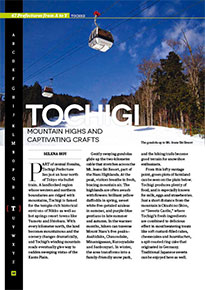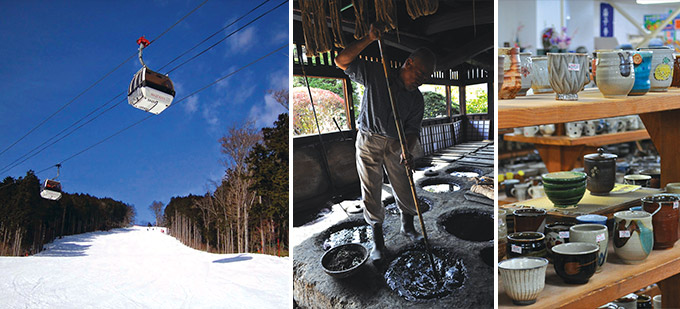Home > Highlighting JAPAN >Highlighting Japan December 2014> 47 Prefectures from A to Y
Highlighting JAPAN

47 Prefectures from A to Y
Tochigi
Mountain Highs and Captivating Crafts

Part of central Honshu, Tochigi Prefecture lies just an hour north of Tokyo via bullet train. A landlocked region whose western and northern boundaries are ridged with mountains, Tochigi is famed for the temple-rich historical environs of Nikko as well as hot springs resort towns like Yumoto and Shiobara. With every kilometer north, the land becomes mountainous and the scenery changes dramatically, and Tochigi’s winding mountain roads eventually give way to sudden sweeping vistas of the Kanto Plain.
Gently swaying gondolas glide up the two-kilometer cable that stretches across the Mt. Jeans Ski Resort, part of the Nasu Highlands. At the peak, visitors breathe in fresh, bracing mountain air. The highlands are often awash with flowers: brilliant yellow daffodils in spring, sweet white five-petaled azaleas in summer, and purple-blue gentians in late summer and autumn. In the warmer months, hikers can traverse Mount Nasu’s five peaks—Asahidake, Chausudake, Minamigassan, Kurooyadake and Sanbonyari. In winter, the area transforms into a family-friendly snow park, and the hiking trails become good terrain for snowshoe enthusiasts.
From this lofty vantage point, green plots of farmland can be seen on the plain below. Tochigi produces plenty of food, and is especially known for milk, eggs and strawberries. Just a short distance from the mountain is Okashi no Shiro, or “Sweets Castle,” where Tochigi’s fresh ingredients are combined to delicious effect in mouthwatering treats like soft custard-filled cakes, cheesecakes and baumkuchen, a spit-roasted ring cake that originated in Germany. Traditional Japanese sweets can be enjoyed here as well. If you’re lucky, you may catch a demonstration by Tadao Kaburagi. This master of confections with fifty years of experience created the shop’s thoroughly light and flavorful cheesecake, which uses an unexpected ingredient—powdered kudzu—for moistness and texture.
To the southeast, the town of Mashiko is a pottery lover’s paradise. There are direct buses here from Tokyo’s Akihabara. Famous for its yakimono (ceramics) since the mid-nineteenth century, called Mashiko-yaki, Mashiko has hundreds of kilns. Pottery shops line the streets, and during the Pottery Festival, tables are placed outside and piled high with crockery: udon bowls, teacups, mugs and hotpots, many glazed in hues unique to Mashiko, like a shade of celadon that comes from using nuka (rice hull), and kaki (persimmon).
Want to get your hands on some clay and create your own artwork? Several places in Mashiko offer a pottery-making experience, such as the Mashiko Pottery Cooperative Selling Center, which has workshops in both wheel and handbuilding. The artisans here make their craft appear effortless. Perhaps you’ll discover an untapped talent, or more likely realize the serious skill and soul that goes into producing these handsome pieces.
Mashiko is also home to the Higeta Indigo Dyeing Center. Indigo, used in Japan for more than a thousand years, is grown domestically and used to dye yarn and fabrics the old-fashioned way at this 220-year-old facility. The center creates items in thirty shades of blue that range from a light sky color to deep navy. Here you can see traditional fabric patterns that have been stenciled with glue, dyed and rinsed to make evocative designs. You can buy products made in the center’s shop as well as observe the dyeing process with advance notice.
Perhaps one can feel and experience the natural attractions, cultural charms and creative artisanal spirit elsewhere as well. However, planning a visit to Tochigi Prefecture will enhance the typical Japan tour in ways both unexpected and unforgettable.
© 2009 Cabinet Office, Government of Japan






